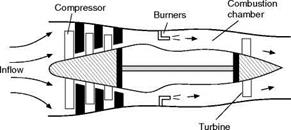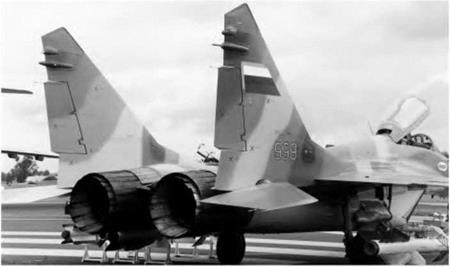Propulsion systems
This is a book on the mechanics of flight, and it would be out of place to go into the thermodynamics of propulsion systems, but we will give a brief description of the basic principles of the more important methods of propulsion. The oldest system, the piston-engine and propeller, is still in common use for light aircraft, and involves a large number of mechanical parts. The propeller itself is, of course, an almost entirely aerodynamic device. In the ramjet and rocket, described later, there are few significant mechanical parts, apart from fuel pumps, and the entire system relies entirely on aerodynamic and thermodynamic principles. Between the two extremes there are the jet and turboprop engines which involve a combination of mechanical and aero-thermodynamic principles.
Turbojet propulsion
Nowadays, the most common form of aircraft engine is the turbojet, which is normally just referred to as the jet engine. The turbojet is in principle, a very simple form of propulsion unit based on the gas turbine engine. A basic version is shown schematically in Fig 4.1. Air enters at the front and its pressure and temperature are raised by the action of the compressor. Heat is added in the combustion chamber by burning fuel (usually kerosene), and the heated air leaves at high speed. Part of the energy that it has gained is used to drive a turbine, which in turn drives the compressor. The air leaves as a highspeed jet. As the speed of the air has increased, the momentum has increased, and the reaction to this momentum change is a thrust force pushing the engine forward. The intake faces forward, in flight, so the air is effectively “rammed” in. This so-called ram effect helps to compress the air, and as the forward speed increases, less and less work has to be done by the compressor, leaving more of the energy increase to be used to generate thrust, so the efficiency of the propulsion system improves.
|
|
Fig 4.1 Principle of the turbojet
|
|
Fig 4A Turbojet propulsion
The hot end of a MiG-29. Two Tumansky R-33D low-bypass turbojet engines, each producing 81.4 kN thrust (with reheat). Note the complex variable area outlet nozzles.
The turbojet is much simpler than the “piston” engines that it has almost entirely displaced, and it has no reciprocating parts to wear and cause vibrations. Most importantly, it produces very much more thrust for a given weight at high speed. An added advantage is that it will work efficiently close to and beyond the speed of sound, where propellers cannot be used, as described later.
The simple type of jet engine shown in Fig. 4.1 has now largely been replaced by the more efficient high by-pass and fan-jet engines described later in this chapter.















